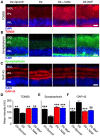Nicotinamide and WLDS Act Together to Prevent Neurodegeneration in Glaucoma
- PMID: 28487632
- PMCID: PMC5403885
- DOI: 10.3389/fnins.2017.00232
Nicotinamide and WLDS Act Together to Prevent Neurodegeneration in Glaucoma
Abstract
Glaucoma is a complex neurodegenerative disease characterized by progressive visual dysfunction leading to vision loss. Retinal ganglion cells are the primary affected neuronal population, with a critical insult damaging their axons in the optic nerve head. This insult is typically secondary to harmfully high levels of intraocular pressure (IOP). We have previously determined that early mitochondrial abnormalities within retinal ganglion cells lead to neuronal dysfunction, with age-related declines in NAD (NAD+ and NADH) rendering retinal ganglion cell mitochondria vulnerable to IOP-dependent stresses. The Wallerian degeneration slow allele, WldS , decreases the vulnerability of retinal ganglion cells in eyes with elevated IOP, but the exact mechanism(s) of protection from glaucoma are not determined. Here, we demonstrate that WldS increases retinal NAD levels. Coupled with nicotinamide administration (an NAD precursor), it robustly protects from glaucomatous neurodegeneration in a mouse model of glaucoma (94% of eyes having no glaucoma, more than WldS or nicotinamide alone). Importantly, nicotinamide and WldS protect somal, synaptic, and axonal compartments, prevent loss of anterograde axoplasmic transport, and protect from visual dysfunction as assessed by pattern electroretinogram. Boosting NAD production generally benefits major compartments of retinal ganglion cells, and may be of value in other complex, age-related, axonopathies where multiple neuronal compartments are ultimately affected.
Keywords: NAD+; WldS; axon degeneration; glaucoma; retinal ganglion cell.
Figures





Similar articles
-
NAD salvage pathway machinery expression in normal and glaucomatous retina and optic nerve.Acta Neuropathol Commun. 2023 Jan 22;11(1):18. doi: 10.1186/s40478-023-01513-0. Acta Neuropathol Commun. 2023. PMID: 36681854 Free PMC article.
-
Neuroprotection by WldS depends on retinal ganglion cell type and age in glaucoma.Mol Neurodegener. 2021 Jun 5;16(1):36. doi: 10.1186/s13024-021-00459-y. Mol Neurodegener. 2021. PMID: 34090501 Free PMC article.
-
The WldS gene delays axonal but not somatic degeneration in a rat glaucoma model.Eur J Neurosci. 2008 Sep;28(6):1166-79. doi: 10.1111/j.1460-9568.2008.06426.x. Epub 2008 Sep 9. Eur J Neurosci. 2008. PMID: 18783366
-
Intrinsic axonal degeneration pathways are critical for glaucomatous damage.Exp Neurol. 2013 Aug;246:54-61. doi: 10.1016/j.expneurol.2012.01.014. Epub 2012 Jan 18. Exp Neurol. 2013. PMID: 22285251 Free PMC article. Review.
-
Glaucoma as a Metabolic Optic Neuropathy: Making the Case for Nicotinamide Treatment in Glaucoma.J Glaucoma. 2017 Dec;26(12):1161-1168. doi: 10.1097/IJG.0000000000000767. J Glaucoma. 2017. PMID: 28858158 Free PMC article. Review.
Cited by
-
Differential protection by nicotinamide in a mouse model of glaucoma DBA/2J revealed by second-harmonic generation microscopy.PLoS One. 2024 Sep 10;19(9):e0309400. doi: 10.1371/journal.pone.0309400. eCollection 2024. PLoS One. 2024. PMID: 39255314 Free PMC article.
-
NAD salvage pathway machinery expression in normal and glaucomatous retina and optic nerve.Acta Neuropathol Commun. 2023 Jan 22;11(1):18. doi: 10.1186/s40478-023-01513-0. Acta Neuropathol Commun. 2023. PMID: 36681854 Free PMC article.
-
Niacinamide and Neuroprotection: The Glaucoma Holy Grail.J Curr Glaucoma Pract. 2022 Sep-Dec;16(3):141-143. doi: 10.5005/jp-journals-10078-1390. J Curr Glaucoma Pract. 2022. PMID: 36793265 Free PMC article.
-
Peripheral blood mononuclear cell respiratory function is associated with progressive glaucomatous vision loss.Nat Med. 2024 Aug;30(8):2362-2370. doi: 10.1038/s41591-024-03068-6. Epub 2024 Jun 17. Nat Med. 2024. PMID: 38886621 Free PMC article.
-
Intravitreal MPTP drives retinal ganglion cell loss with oral nicotinamide treatment providing robust neuroprotection.Acta Neuropathol Commun. 2024 May 21;12(1):79. doi: 10.1186/s40478-024-01782-3. Acta Neuropathol Commun. 2024. PMID: 38773545 Free PMC article.
References
Grants and funding
LinkOut - more resources
Full Text Sources
Other Literature Sources
Medical
Molecular Biology Databases

